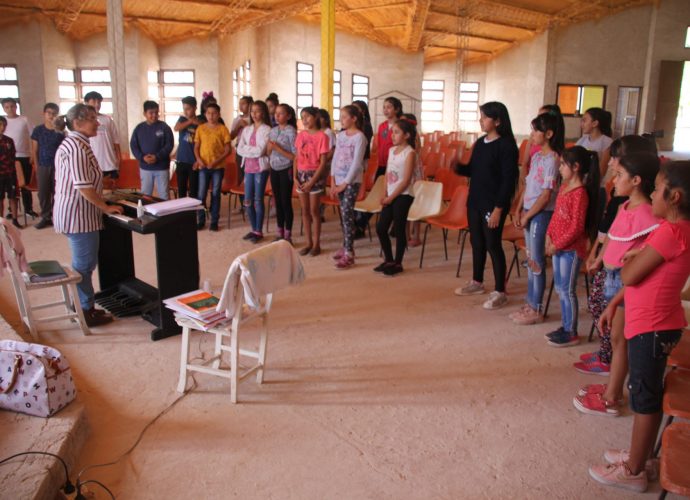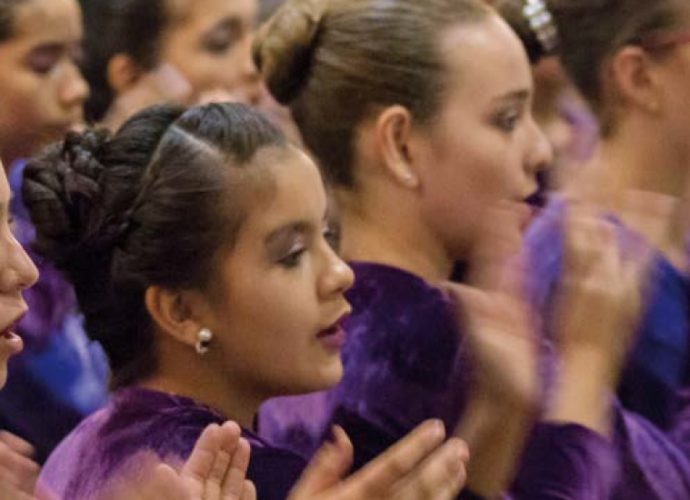Choral Memory: Developing & Sustaining Tonal Excellence in Choirs (Page 24)
Choral Memory:
Developing & Sustaining Tonal Excellence in Choirs
By Carol Beynon, Jennifer Beynon-Martinec and Jakub Martinec
As the title of this paper implies, the concept of choral memory, referring to the development and sustainability of a distinctive sound within a choir over a period of time, may be one indicator of the health and longevity of a choral organization. Is it possible that this term, derived from the business and administration theories of organizational memory may inform our understanding about development and growth in choirs? The authors of this paper have a cumulative 60 years of experience as conductors of boys’ and men’s choirs and the subject of the development of choral tone is a constant area of discussion and research in their work. We begin this paper with a brief narrative account.
The primary author was the co-founder of the community-based Amabile Boy’ & Men’s Choirs. While the numbers of male singers were reasonably constant and healthy, and parental and community support and enthusiasm were high, the first few years were a struggle musically. Each season, half of the treble choir would move into the male youth choir as their voices began the inevitable change process and we would start developing a sound all over again with 8 and 9 year old non-readers and inexperienced singer musicians. At the same time, the newly changed voices with their extremely limited range and unpolished tone quality would move into the developing Tenor-Bass choir, trying to learn to sing with a brand new and often unpredictable voice. As a result both the treble and youth male choirs sounded young and immature.
None of the story told thus far is news to anyone who has worked with boys’ choirs anywhere in the world. Each time he heard us perform and listened to our frustrations about the lack of growth in choral tone, Amabile conductor colleague, John Barron CM, would say that the choirs would develop a good choral tone over time and a sense of choral memory would emerge once the singers themselves had a concept of choral tone in their own minds. With patience and consistent, good teaching, he said the sound that we were seeking would begin to emerge, and once it was there, it would lock in and even the new choristers would almost automatically pick up our sound.

Coincidentally in the third season, four university students and experienced singers joined the Tenor-Bass youth choir, and even though they only represented four of the 25 members, their singing provided a solid foundation on which to build a more mature choral sound and provided examples for the younger adolescent boys to emulate. That season, finally, the choristers with younger voices began to make a dramatic change in developing an acceptable choral sound. The next season, the university students graduated and there was no one of similar voice or maturity to replace the former leaders. However, even though the older students were no longer in the choir, listeners commented on mature sound of the youth male choir. Having these four young men in the choir seemed to be the catalyst for the other singers to hear a model they wanted to emulate and to work harder to develop a better choral tone. During that one year, the older voices served to imprint the sound of the entire Amabile Young Men’s Ensemble in a permanent way, and all of the singers began to understand and have a sense of the choral tone they wanted to achieve. Reverting back to the previous immature sound would have seemed obvious since the new members who came into the choir had newly changing voices without much tone colour. However, the highly-motivated singers and conductors moved collectively forward from that point to continue their development of a more mature and polished tonal quality within the choir. Their choral tone was a subject of constant subject of discussion amongst the members on a regular basis and the choir gradually became known for its artistic excellence and through a concept of choral memory, became known for its distinctive warm tone colour.
Their own choral experience and John Barron’s sage advice about the concept of choral memory caused these authors to consider the concept of choral memory from a theoretical perspective. A search through the choral literature yielded no clues. Perhaps, we thought, organizational theory could help us to understand why certain choral organizations grow and flourish, while others remain static and/or unremarkable.
Organizational Learning. The ability for an inanimate object such as an organization to have personal capacities to learn seems unique. The pioneer of organizational learning theory, Peter Senge (1990) posits that learning occurs when organizations interact with their environments and grow or improve through increasing their understanding of what it is they do. While the actions an organization takes may be experimental, imitative, adaptive or carefully planned, an organization’s ability to learn may make the difference between its thriving or perishing in the years ahead. The literature on organizations would indicate that an organization’s growth–or lack thereof–becomes a collective of the people who work within that organization, and cumulatively, each person’s action–or inaction–leads to or away from organizational productivity or what is called learning in the literature. In other words, it is the notion of a community of learners that emerges in relation to organizational and cultural structure and change emanates from the understandings about the nature of learning. But, organizational/community learning is not merely the sum of the individual member’s learning. In fact, it is–and this is a fact most applicable to choir development–the lowest common denominator in organizational learning. The research shows that individual learning, instead of guaranteeing learning, may indeed inhibit or prevent organizational growth. It is critical that the whole organization learn, not merely rely on one expert’s knowledge (i.e., conductor) but to rely on social interaction for group learning (Mitchell & Sackney, 2000). The relationship, then, between individual and members within the community is critical, and is based on an interactional model of causation in which personal factors associated with individuals, environmental events and behaviours operate as interacting determinants of one another. Human learning in the context of a particular community of learners is not only influenced by the organization, but has consequences for it and produces phenomena at the organizational level that go beyond anything we could infer simply by observing learning processes in isolated individuals. Human rationality complicates the concept even further. Organizational learning occurs if any members (i.e., individual singers, conductor, or accompanist) and units (i.e., sections) acquire knowledge that can change the range of behaviours of the organization.
Organizational memory has been continually recognized as an integral component of an organization’s ability to learn. Even when seemingly critical members leave the organization, enough collective wisdom or memory is left behind for incumbents and new members to make the organization continue to grow. Thus, a significant component of organizational learning is that of organizational memory. Organizational memory is grounded in information acquisition, storage, and transmission rooted in the beliefs, theories and ideologies of the culture which are conserved through systems of socialization, experimentation and control. Memory is knowledge stored in indexes and encyclopedic form and choirs (i.e., conductors, accompanists, singers) have vast stores of such information. Organizations have repertoires of activities for acquiring the information and improving what organizations can do. Building and modifying the repertoire are fundamental activities because they embody learning in routines, thus constituting a major form of organizational memory. Even when the participants leave, organizational memory protects the organization so it can survive and grow further (Senge, 1990). Building upon and modifying the repertoire constitute a major form of organizational memory (e.g., repetition of an existing piece of repertoire). Participants in an organization are the ones who decide on the worthiness of information that emanates from the leader and organizational memory is represented by the structures used to retrieve, organize, modify, and/or even make use of that knowledge. Participants decide how the information is coded, processed and even retrieved. Past experience is of utmost importance in creating change in an organization because memories of previous successes tend to invoke further risk-taking and dynamic innovation.

Choral Memory. While choral organizations are seen as instruments of the aesthetic, they are often based on a rationale and rigid structure that is linear, involves chain-of-command decision-making, differentiation of tasks, hierarchical supervision above and within the choir, formal rules and regulations, and professes certain ideologies. While social relationships are seen as an integral component of choirs, collaborative decision-making is not. Development may be based on repeated practices–regardless of participants–and change is both cosmetic and short-lived. But second order change or penetrating, intensive restructuring requires a deeper level of organizational management.
Choral memory is a multi-faceted phenomenon that evolves in a choir even in its first year of existence, involves learning and unlearning, and is essential for the growth of the organization. There is the memory that serves the bureaucratic structures of the choir, the memory that serves as a foundation for a music education program and applies to the individual level of each singer in the choir, and there is the choral memory of the sound that emerges and becomes idiosyncratic to the choir. As expert choral conductors work to transform vocal technique, musicianship and pedagogy into their concept of sound within the ensemble, the tonal quality develops and settles as a basic constant and consistent foundation over time. While the distinctiveness and singularity of that tone is a requisite to most conductors, it is maintained through continuous chorister development as well as conductor growth. Most conductors and their singers, however, are never totally satisfied with the sound even at its most mature level. Nor can they afford to be complacent in this regard because it is the ongoing development in technique, repertoire and performance standard that not only sustains the foundation of the sound but keeps improving it. It is this ongoing development in the learning community that ensures the choir is a healthy learning community. We posit that there are two factors at work: 1) it is the sustainability of the particular sound that indicates a healthy community of learners; and, 2) it is the ongoing strengthening and maturing of that choral sound that comes with longevity.
At the beginning of a new season, conductors of seasoned choirs often report that, even though a large percentage of the membership may have changed, it is always amazing yet ameliorating to hear the first warmups and recognize the distinctive but familiar choral sound of the choir. How does this happen? One would think that a choir’s sound is based on the distinctive voices of the immediate singers and coloured by the personalities within the group. But, initial findings are showing that this is a false assumption. The indicator seems to be a sense of organizational choral memory that is more entrenched than the collection of individuals in the choir. This information was borne out in conversations we had with six choral conductors of excellent community-based children’s, youth and adult choirs about the phenomenon of their choral sound in their choirs. Their comments served to affirm our belief that choral memory does evolve over time and indeed indicates that these choirs did become learning communities. The overall sound in elite choirs is coloured by the conductor’s ability to train and develop that sound based on a particular preference that s/he has. Even idiosyncratic voices can be honed into a definitive sound that is particular to that conductor and this process begins with the advent of a new program or new conductor. These experienced conductors told us that choral memory involves learning vocal technique and then unlearning certain technique as new and more advanced information and/or abilities replace preliminary instruction.
Organizational learning theory fits the context of the personal example with which we began this paper. In relation to tonal development in these beginning male choirs, John Barron wisely advised that a conductor must have a concept of sound in mind and must continue working toward it even though the environment is always in a state of flux. In this one case study, the university students contributed to both an event and a process of organizational learning because the choir as a unit was ready to learn; they worked together to develop a sound that not only began to emulate and complement the older singers, but also began to emerge as a cohesive sound unit. How this learning occurred is interesting and vital to understanding how choirs develop. The concept of choral memory has the potential for helping us understand how healthy choral organizations develop, and these initial findings point to a need for further research to explore the fit between organizational theory and choral development.
References:
Mitchell, C., & Sackney, L. (2000). Profound improvement: Building capacity for a learning environment. Tokyo: Swets & Zeitlinger.
Newton, P.M. (2005) Ensemble Learning: A Lens for Group Learning in Schools.
The Journal of Educational Thought.39(1): 75 – 88.
Senge, P. (1990). The Fifth Discipline. NY: Doubleday.
Turc, E. & Baumard, P. (2007). Can organizations really unlearn? In McInerney, C. Day, R. (Eds.). Rethinking Knowledge Management, pg 125 – 146.
About the Authors:
The co-authors of this article are specialists in the training and development of boys and men’s voices.
 Dr Carol Beynon is Co-artistic Director of the Amabile Boys & Men’s Choirs of London, Canada, Associate Professor of Music Education, and Associate Vice Provost of the Graduate & Postdoctoral Studies at the University of Western Ontario. E-mail: beynon@uwo.ca
Dr Carol Beynon is Co-artistic Director of the Amabile Boys & Men’s Choirs of London, Canada, Associate Professor of Music Education, and Associate Vice Provost of the Graduate & Postdoctoral Studies at the University of Western Ontario. E-mail: beynon@uwo.ca
 Jennifer Beynon-Martinec is a specialist in vocal technique and conductor of the Young Men’s Choir in Boni Pueri, music teacher with the English International School, and a faculty member in vocal and choral pedagogy at Charles University in Prague. She is a former member of the World Youth Choir. E-mail: beynon-martinec@bonipueri.cz
Jennifer Beynon-Martinec is a specialist in vocal technique and conductor of the Young Men’s Choir in Boni Pueri, music teacher with the English International School, and a faculty member in vocal and choral pedagogy at Charles University in Prague. She is a former member of the World Youth Choir. E-mail: beynon-martinec@bonipueri.cz
 Jakub Martinec is assistant head master of Boni Pueri, the Czech Boys Choir School and conductor of the Boni Pueri touring choir. With Boni Pueri, he has conducted performances in many of the great concert halls in the world. E-mail: martinec@bonipueri.cz
Jakub Martinec is assistant head master of Boni Pueri, the Czech Boys Choir School and conductor of the Boni Pueri touring choir. With Boni Pueri, he has conducted performances in many of the great concert halls in the world. E-mail: martinec@bonipueri.cz










